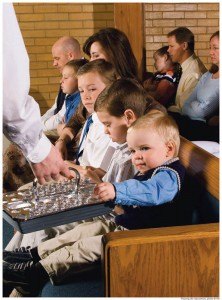In general, LDS sacrament meetings require little more than reverent attention of its members. However, the passing of the sacrament, similar to communion in other churches, is one part of the meeting in which we all participate.
The sacrament allows us to renew our baptismal covenants and be reminded of the promises God made to us at that time and that we made to God. Ask your missionaries if you should take the Sacrament when it’s passed. While it is meant to renew covenants, no one will be offended if you choose to partake before your baptism. Children are allowed to do so even before they turn eight years old, the age of baptism.
 The sacrament is based on the Last Supper. This was the last time the Savior met with his apostles. He broke bread and told them to eat it in remembrance of his body, which died for them. Then he gave them wine, which was to be taken in remembrance of the blood he shed for them on the cross. He repeated this ordinance in his visit to the Nephites, recorded in the Book of Mormon.
The sacrament is based on the Last Supper. This was the last time the Savior met with his apostles. He broke bread and told them to eat it in remembrance of his body, which died for them. Then he gave them wine, which was to be taken in remembrance of the blood he shed for them on the cross. He repeated this ordinance in his visit to the Nephites, recorded in the Book of Mormon.
Today, we are also commanded to partake of this special ordinance. We use water instead of wine today, but the remembrance is the same.
The members prepare for the taking of the sacrament by singing a sacrament hymn. The hymn is one specifically chosen to help us remember the purpose of what we are about to do. There are many LDS hymns on this subject, and the music leaders select different ones each week. LDS.org, the official church site, has the words and music to many of these hymns, which can be listened to or downloaded at no cost. Look under the heading Sacrament.
On the stand in the chapel, you will see two priesthood holders, who hold the priesthood level of priest (minimum age sixteen) or higher, preparing the Sacrament during the hymn. They break the bread. The water was placed in small cups prior to the meeting. When the song ends, the members of the congregation bow their heads, close their eyes, and listen carefully to the sacrament prayer on the bread, given by a priest who is kneeling. Members remain in their seats.
Then boys or men who hold the priesthood level of deacon (minimum age twelve) or higher pass the sacrament to the members of the congregation. When they reach your aisle, they will hold the tray for the first person, who takes a single piece of bread with his right hand and eats it. He then takes the tray and holds it for the next person. This continues until the end of the aisle, when another deacon takes it. If you’re in a pew on the wall or have a large space between you and the next person, the last person should return it to the deacon who gave it to you or pass it back down the row to him. Parents should assist small children. People who are in the foyer, perhaps because their children are fussing, are taken the sacrament there.
You can read the words of the two prayers in the Doctrine and Covenants, section 20, verses 77-79.
If you are on the end of the aisle and can’t remember what to do, ask the deacon or a member near you for help. They will be happy to show you what to do.
This process is repeated for the water. Take the small individual cup when offered, and then place it in the center of the tray when you’re finished.
While waiting for the sacrament to be passed, members silently read scriptures about the Savior or ponder his life. Small children often find it helpful to look at pictures of the Savior while they wait. Members should attempt to not leave the chapel during this time. The doors are closed so others cannot enter, as well. It is meant to be a very quiet and reverent moment of communion with the Savior.
To learn more about the Sacrament, read the chapter on the sacrament in the Gospel Principles book. It is free to read in its entirety and is a basic introduction to church doctrine.
About Terrie Lynn Bittner
The late Terrie Lynn Bittner—beloved wife, mother, grandmother, and friend—was the author of two homeschooling books and numerous articles, including several that appeared in Latter-day Saint magazines. She became a member of the Church at the age of 17 and began sharing her faith online in 1992.


